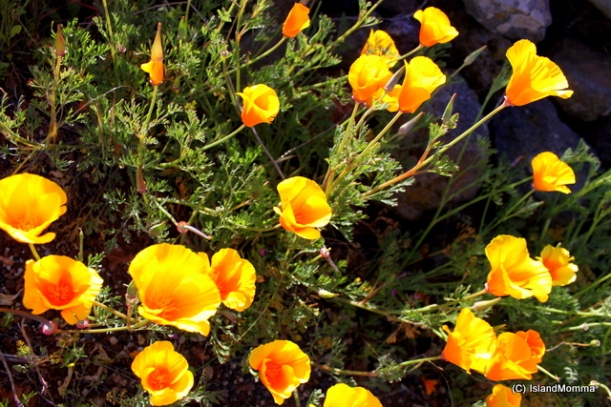Vilaflor is a village usually overlooked by tourists as their buses hurtle past in search of the dramatic landscapes of the Teide National Park, and whilst I have no desire to rob the 2,000 or so inhabitants of the village of potential revenue, I breathe a sigh of relief as I type that. If the pueblo does cross the consciousness of the average visitor to Tenerife, it’s because it boasts the title of “Spain’s highest village.” That is disputed, and, hard to get into my skull, having stood on the slopes of the snow-clad Sierra Nevada. Even in chill mid-Winter the snow doesn’t come down this far.
Today I am in search of spring, yet again. You must excuse my excessive enthusiasm. You see I’ve never been too much of a fan of the season, and certainly have never seen it throw such an extravagant display on this island as it has done this year.
Driving up to Vilaflor I take the snaps you saw in the previous post; appropriately canary-yellow wild fennel, delicate, mauve poppies, and sunny California poppies.
Flor is Spanish for flower, and it’s understandable that you would think the village is named for the glorious displays we’re seeing. Not so, and the story of its rebirth, if not its founding, is sad, and romantic, and to put it in modern terms, it’s a story of culture clash.
Tenerife was the last of the Canary Islands to fall to the Spanish conquistadors in 1496. The indigenous Guanche, described later by their conquerors as noble and brave, had fought fiercely, but in the end succumbed to the superior weaponry and equipment of their foes.
Although the dimensions of Tenerife couldn’t be more different from those of the Americas, the stories of what happened to the Guanche often have a ring of what happened to the natives of those continents. A people who lived in harmony with the earth, whose gods represented the universal order of things – the earth, sun, moon – were beaten, humiliated, enslaved, exhibited in the Spanish court and probably died of diseases brought by their captors. Some were converted to “Christianity” (ever the excuse for conquest and colonization), and absorbed into “civilized” society, leaving their inheritance to whither. Only in fairly recent times have historians begun to really try to piece together what information remains to form a more complete picture.
This then, is the background to our story, and into this scenario rides one Pedro Bracamonte, a captain in the conquering forces of Alonso Fernández de Lugo. Pedro is dispatched by his commander to explore the verdant hillsides around Chasna, a Guanche settlement. With the arrogance typical of tyrants, seeing a beautiful, young Guanche maiden, he holds her against her will for several days, before she is able to make her escape into the surrounding forest.
His arrogance, however, is his undoing. In those brief days he falls deeply in love with the girl. He pursues her desperately through territory which is her friend and his foe, with its deep valleys, caves and thickly wooded slopes, but he can find no trace. Within three months our conquering “hero” dies from a broken heart. With his last breath he indicates that at least he dies having seen the flower of Chasna – Vi la flor de Chasna.
As with many so-called “love stories” my first reaction is a long sigh, and then “serves him right” cuts in. As Guanche culture clashed with Castellano, so my modern perception of history clashes with this charming tale. Still, it’s a story, and stories make the world go around.
Today’s Vilaflor de Chasna truly is a contrast to “el cemento” on the tourist coast of Tenerife. It is sleepy (except for fiesta days!). It fairly twinkles with well-kept pride, its streets clean but not sterile. And despite the legend, its name seems apt, as flowers fill every nook, cranny and corner. A lovely, 90-year-old lady I meet in the village square tells me that the delightful juxtaposition of modern water feature with beds of wildflowers, the renovations of the carved-wood, Canarian balconies, and the general loveliness of the tiny town is all down to the mayor, who always has her vote “even though he’s a socialist”……..a true democrat! Perhaps it’s that sense of truly shared civic pride which is reflected in the atmosphere, and makes this place special. I certainly don’t know anywhere else quite like it on this island.
Today seems quite busy for a weekday. The little tourist information kiosk in the pretty and peaceful square has something of a queue – three groups of people, including me, and another dozen or so sip coffee outside the bar nearby. All dressed in walking gear, they are mainly German and Scandinavian, save for one middle-aged lady in a pretty red and white dress and a sun hat. I can’t help hoping that her husband is going to take a photo of her in one of the glorious fields of California poppies we passed, the colors would be so good.
When Flor de Chasna fled her captors there were no California poppies in the Canary Islands. They arrived, intentionally or not, on the trade ships which crossed the Atlantic with treasures from North America, but, these flowers which seem to capture the very sunshine – I like to think she would have liked them.










